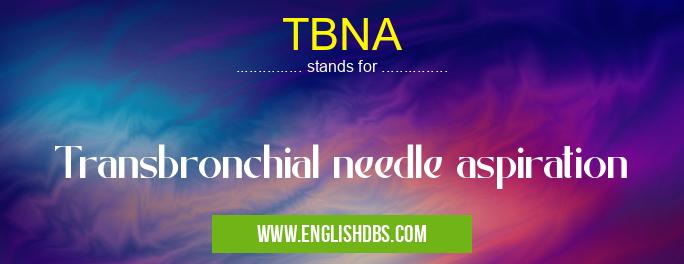What does TBNA mean in LABORATORY
Transbronchial needle aspiration (TBNA) is a minimally invasive procedure that is used to obtain tissue and fluid samples from the lungs. This technique is typically employed when medical imaging such as an X-ray, CT scan, or MRI fails to provide enough information for making a diagnosis. TBNA is conducted using thin needles inserted through the bronchial walls of the patient’s lungs. It can be performed with local anesthesia and is useful in diagnosing and treating benign conditions such as tumors, infections, and inflammatory diseases.

TBNA meaning in Laboratory in Medical
TBNA mostly used in an acronym Laboratory in Category Medical that means Transbronchial needle aspiration
Shorthand: TBNA,
Full Form: Transbronchial needle aspiration
For more information of "Transbronchial needle aspiration", see the section below.
» Medical » Laboratory
Procedure
TBNA requires the use of a flexible endoscope with light and camera, which is guided through the airways into the targeted area. Once positioned correctly within the lung tissue, a thin needle attached to an aspirating syringe will be inserted through one of the airways. The physician will then attempt to extract cells or fluid from the targeted area and place them onto slides for further examination by a pathologist. Aspiration can also be used to remove masses that have been found on medical imaging tests. The procedure generally takes between 15 to 30 minutes depending on how many samples are taken.
Benefits
In comparison to other tissue sampling methods such as bronchoscopy or biopsy side effects associated with TBNA are much fewer due to its minimally invasive nature. Whilst there may be minor adverse reactions such as soreness of an arm due to anesthesia or some bleeding this usually subsides quickly after treatment has been completed. Furthermore, it enables physicians to obtain samples directly from suspected areas and take multiple biopsies if needed without having to perform general surgery which often carries far greater risks than this procedure does. Additionally, results from this test are available in days rather than weeks compared other methods due to its speediness in taking cell specimens.
Essential Questions and Answers on Transbronchial needle aspiration in "MEDICAL»LABORATORY"
What is a transbronchial needle aspiration (TBNA)?
Transbronchial needle aspiration (TBNA) is a medical procedure where a small sample of tissue and/or fluid from the lungs or surrounding structures is taken for diagnostic purposes. This is usually done through endoscopic bronchoscopy, a technique in which an endoscope (a thin tube with light source and camera) is used to view inside the airways during the procedure.
Who needs TBNA?
TBNA may be recommended for someone who has an abnormal finding on a chest X-ray or CT scan that requires further evaluation. It may also be recommended for someone with an unexplained cough, shortness of breath, or other respiratory symptoms that are not easily explained by other tests.
What does the TBNA procedure involve?
During the procedure, an endoscope is inserted through the mouth and down into the lungs. The doctor uses this device to visualize inside of the airways while they use a specific type of needle to extract small samples of tissue from different parts of the lung. After the tissue samples are collected, they are sent off to a laboratory for analysis.
Is TBNA safe?
Yes, TBNA is generally considered a safe procedure as it involves inserting only a thin needle into the lungs and does not require any incision or damage to healthy tissue. As with most medical procedures, there can be some risks involved such as bleeding and infection at the sites where needles were inserted. These risks can be minimized by carefully following all instructions provided by your healthcare team before and after your procedure.
How long does a TBNA Procedure take?
The actual time spent performing the TBNA procedure varies depending on how many samples are taken and how far into the lungs they need to go but typically it takes between 15-45 minutes.
Is any pain involved in a TBNA Procedure?
You may experience mild discomfort while passing through your airways during insertion of the endoscope, however there should be no severe pain associated with this procedure. During extraction of samples with TBNA you might experience minimal pressure or some feeling similar to getting an injection at most times nothing at all can be felt. Any feelings should pass quickly once complete.
What happens after I have had my Transbronchial Needle Aspiration Procedure?
After your Transbronchial Needle Aspiration Procedure you will likely need rest as instructed by your health care team - rest ensures proper healing process so it’s important to follow their instructions for recovery properly. You may also receive antibiotics or other medications depending on what was found during your procedure - make sure you follow all instructions regarding taking these medications properly if prescribed them. Your health care provider will discuss test results at your follow up visit which will help determine appropriate treatments going forward.
Final Words:
Transbronchial needle aspiration is a quick, safe diagnostic procedure which allows physicians access hard-to-reach areas of the lungs for sample collection purposes while avoiding major issues associated with more invasive procedures such as biopsy or surgery. The targeted cells obtained from TBNA allow pathologists and radiologists make more informed decisions concerning a patient's diagnosis which ultimately enables better care for their particular condition.
